- This
photo feature tells you about the temple and shares pictures of the temple,
both outside and inside.
Our recent trip to Madurai was highlighted by a visit to the magnificent Arulmigu Meenakshi Sundareswarar Temple, a breathtaking spectacle of Dravidian architecture and a vibrant testament to the city's rich cultural and religious heritage. This temple, dedicated to Goddess Parvati (Meenakshi) and Lord Shiva (Sundareswarar), is not just a place of worship; it's a living, breathing city within a city, pulsating with devotion and artistry.
Stepping
into the temple complex was like entering another world. The sheer scale and
intricate detail of the gopurams (towers) were overwhelming. Adorned with thousands of sculptures
depicting deities, celestial beings, and scenes from Hindu tradition, each
gopuram is a masterpiece in itself. We
were particularly captivated by the iconic south gopuram, a towering structure
that pierces the sky, a testament to the architectural prowess of the Pandya
dynasty. The temple has 14 Gopurams in total; but the main ones are located at
the North, South, East and West entrances. Gods, Goddesses and stories from
Hindu scriptures adorn the Gopuram. The Temple is mentioned in Tamil Literature
as early as the 7th Century AD.
The temple's architecture is a stunning example of Dravidian artistry at its finest. The complex is a maze of halls, shrines, and mandapams (pillared halls), each with its unique significance and intricate carvings. The famous "Hall of Thousand Pillars" (Ayiram Kaal Mandapam) was a sight to behold, a vast space supported by intricately carved pillars, each telling a story. We also marveled at the "Musical Pillars," which produce different musical notes when struck.
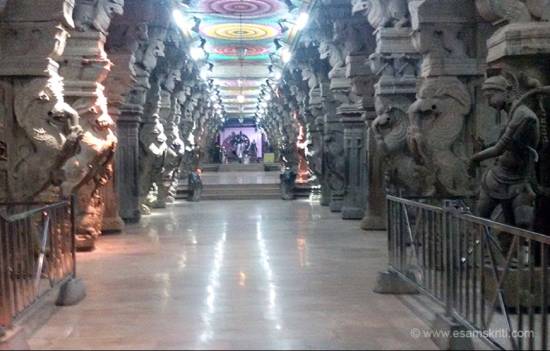 Inside the thousand pillared hall which has 985 beautifully sculptured pillars. The Temple Museum is situated inside this Hall.
Inside the thousand pillared hall which has 985 beautifully sculptured pillars. The Temple Museum is situated inside this Hall.
Beyond the architectural grandeur, the temple is steeped in tradition and legend. Meenakshi, the fish-eyed goddess, is believed to be an incarnation of Parvati. The legend says she was born as the daughter of a Pandya king and later married Lord Shiva, who appeared as Sundareswarar (the handsome one). The divine marriage is celebrated annually with a grand festival, the "Thirukalyanam," which attracts thousands of devotees from around the world.
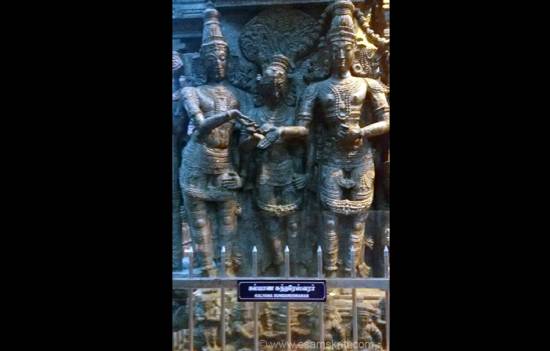 Kalyana Sundareshwirar. “Madurai is an ancient city. The Ramayana refers to it, so does Kautilya's Artha Sastra, Megasthenes wrote about Madura in 302 BC.”
Kalyana Sundareshwirar. “Madurai is an ancient city. The Ramayana refers to it, so does Kautilya's Artha Sastra, Megasthenes wrote about Madura in 302 BC.”
Our visit coincided with the evening "Pooja," and the atmosphere was electric. The rhythmic chanting of the priests, the fragrance of incense, and the vibrant colors of the devotees' attire created a truly spiritual experience. We felt a sense of peace and tranquility amidst the bustling activity.
Tourist Information
Best
Time to Visit: The ideal time to visit Madurai is during the cooler months
(October to March). Avoid the summer
months due to the extreme heat.
Temple Timings: 5:00 AM to 12:30 PM and 4:00 PM to 10:00 PM
Accommodation
& Transportation: Madurai is well-connected by air, rail, and road, with
the temple being easily accessible from the city center.
Madurai has a wide range of hotels and lodges, catering to different budgets
and preferences
Ticket
Prices: Free entry, but a nominal fee is charged for special darshan (viewing)
and puja (worship) services.
Online
booking at https://maduraimeenakshi.hrce.tn.gov.in/
Dress
Code: Modest attire is required.
Shoulders and knees should be covered.
Men may wear dhoti or pants and shirts. Women can wear sarees or
churidars with a dupatta. Avoid wearing
revealing clothes.
Photography: Photography is allowed in some areas of the temple, but restrictions may apply in certain sanctums. It's always best to check the local regulations.
Footwear:
Footwear is not allowed inside the temple.
You can leave your shoes at the designated stands outside.
Crowds:
The temple can get very crowded, especially during festivals and weekends. Be prepared for large crowds and plan your
visit accordingly.
Guides: Hiring a local guide can enhance your experience by providing valuable insights into the temple's history, architecture, and mythology.
Accessibility:
Navigating the complex can be challenging for those with mobility issues due to
uneven surfaces and steps.
Prasad: After your visit, don't forget to collect the "Prasad" (blessed offering) from the designated counters.
Important Associations & Traditions
1.
Meenakshi: The principal deity of the temple, believed to be an incarnation of
Parvati.
2.
Sundareswarar: The consort of Meenakshi, representing Lord Shiva.
3.
Thirukalyanam: The divine marriage of Meenakshi and Sundareswarar, a major
festival celebrated annually.
4. Pandya Dynasty: The temple's construction and expansion were largely carried out by the Pandya kings.
5.
Dravidian Architecture: The temple is a prime example of Dravidian
architecture, characterized by its towering gopurams and intricate carvings.
A visit to the Meenakshi Amman Temple is more than just a sightseeing tour; it's an immersive experience that engages all your senses. It's a journey into the heart of Tamil Nadu's rich cultural heritage and a glimpse into the deep devotion that permeates every aspect of life in Madurai. As we explored the temple complex, we were struck by the sheer scale and grandeur of the gopurams, mandapams, and shrines, and the legend of Meenakshi and Sundareswarar continues to inspire and captivate us. Whether you are a devotee, a history buff, or simply a curious traveler, the Arulmigu Meenakshi Sundareswarar Temple is a must-visit destination that promises to leave you enchanted and inspired.
Now sharing pictures. Pics clicked in 2016. All pics copyright www.esamskriti.com except one by Mahesh.
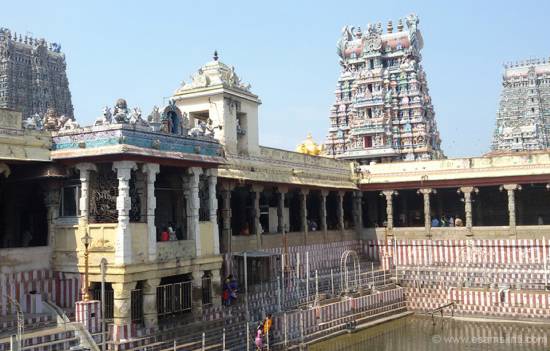 U see the Golden Lotus Tank. According to tradition Indra worshipped Bhagavan Shiva with Golden Lotus from this tank.
U see the Golden Lotus Tank. According to tradition Indra worshipped Bhagavan Shiva with Golden Lotus from this tank.
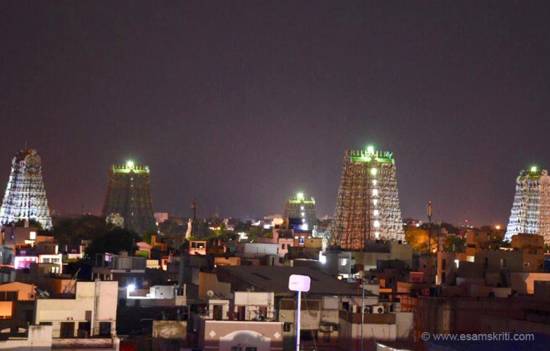 Pic Mahesh Venkateswaran. “Madurai's temple architecture exhibits a seamless synergy of distinctive aesthetics of its rulers. If Pandya rulers, till 1334, gave its majestic towers, Vijayanagara kings 1377-1560 added monolithic pillars & Nayaks 1600-1750 large prakarms and pillared halls.”
Pic Mahesh Venkateswaran. “Madurai's temple architecture exhibits a seamless synergy of distinctive aesthetics of its rulers. If Pandya rulers, till 1334, gave its majestic towers, Vijayanagara kings 1377-1560 added monolithic pillars & Nayaks 1600-1750 large prakarms and pillared halls.”
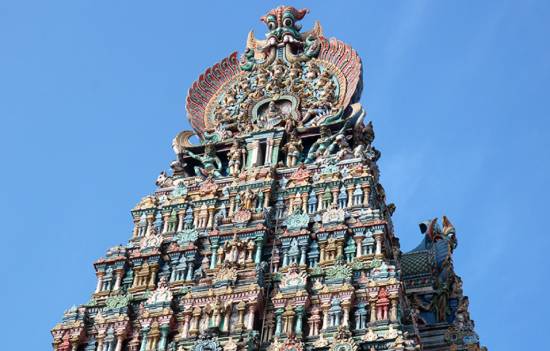 Centre top is Kirti Mukha i.e. found everywhere. It is to keep away evil spirits. “This is a twin temple. Southern side is dedicated to Devi Meenakshi and other to Lord Sundareswarar.”
Centre top is Kirti Mukha i.e. found everywhere. It is to keep away evil spirits. “This is a twin temple. Southern side is dedicated to Devi Meenakshi and other to Lord Sundareswarar.”
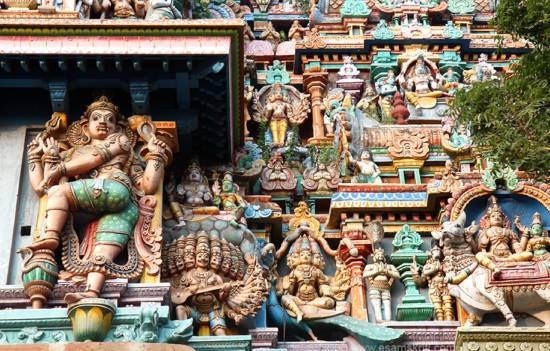 Mid-level view. The original Meenakshi Temple was razed to the ground in 1311 by Malik Kafur. The sanctum however survived. In 1510 Vishwanatha Nayak remade the temple at the same spot.
Mid-level view. The original Meenakshi Temple was razed to the ground in 1311 by Malik Kafur. The sanctum however survived. In 1510 Vishwanatha Nayak remade the temple at the same spot.
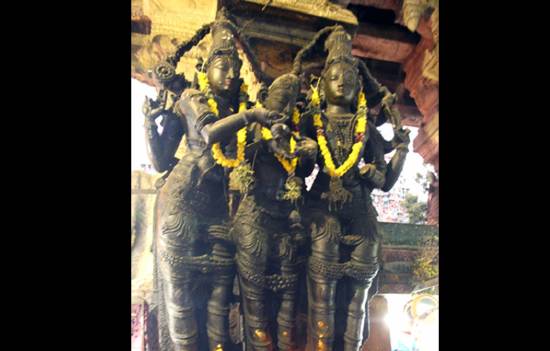 Meenakshi Kalyanam - Mahavishnu giving away (kanyadhan) Meenakshi to Somasundarar.
Meenakshi Kalyanam - Mahavishnu giving away (kanyadhan) Meenakshi to Somasundarar.
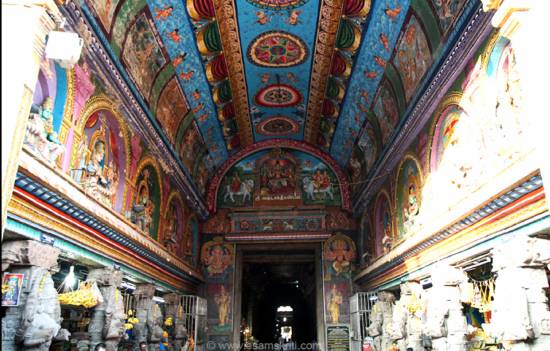 East side
entrance.
East side
entrance.
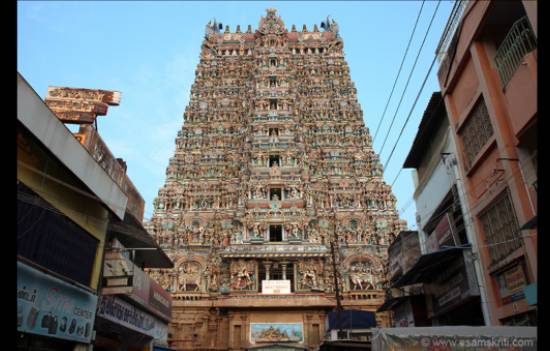 West side tower, imposing. “This was constructed by King Parakrama Pandian during his reign between 1315 and 1347. This has a height of 154.6 feet with a base length of 101 feet and a width of 63.6 feet. This tower houses 1124 sculptures of mythological importance.”
West side tower, imposing. “This was constructed by King Parakrama Pandian during his reign between 1315 and 1347. This has a height of 154.6 feet with a base length of 101 feet and a width of 63.6 feet. This tower houses 1124 sculptures of mythological importance.”
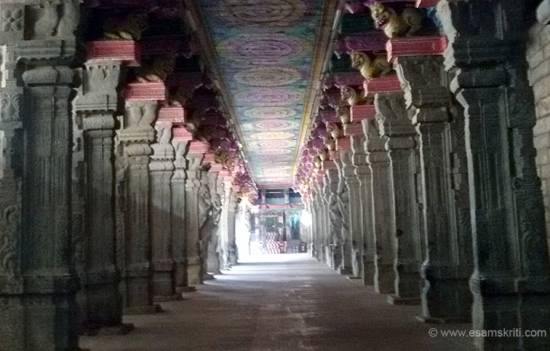 Long Corridors with painted ceilings.
Long Corridors with painted ceilings.
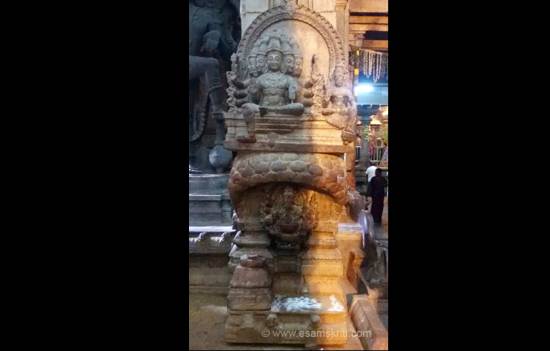 Arumugan or Lord Muruga with his consort. Below him is Ganesha.
Arumugan or Lord Muruga with his consort. Below him is Ganesha.
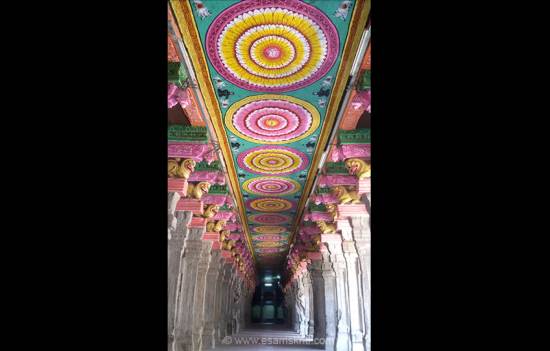 Pic of corridor.
Pic of corridor.
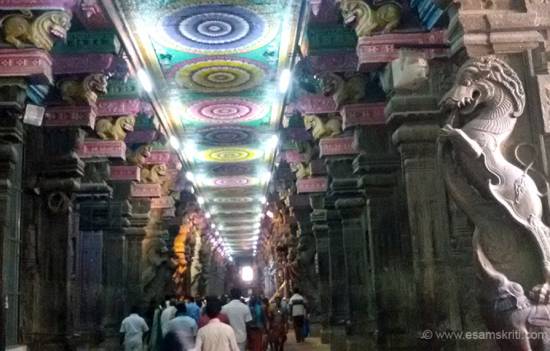 Note mythological animal YALI on right of pic.
Note mythological animal YALI on right of pic.
 Shiva and Parvathi on Mt.Kailash. When Ravana attempts to lift Mount Kailash, Shiva presses him down. Immediately realising his mistake, Ravana sings Saama Gaanam playing his Veena. Centre of pic is Ravana trying to lift Mount Kailash with Siva and Parvati seated on top.
Shiva and Parvathi on Mt.Kailash. When Ravana attempts to lift Mount Kailash, Shiva presses him down. Immediately realising his mistake, Ravana sings Saama Gaanam playing his Veena. Centre of pic is Ravana trying to lift Mount Kailash with Siva and Parvati seated on top.
Close
by temples are Murugan (30 minutes away) and Srivilliputhur.
 Gopuram, Murugan
Temple Madurai.
Gopuram, Murugan
Temple Madurai.
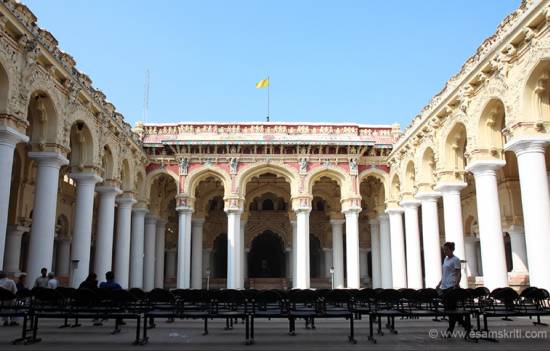 Nayak Palace in Madurai is about 15 minutes away.
Nayak Palace in Madurai is about 15 minutes away.
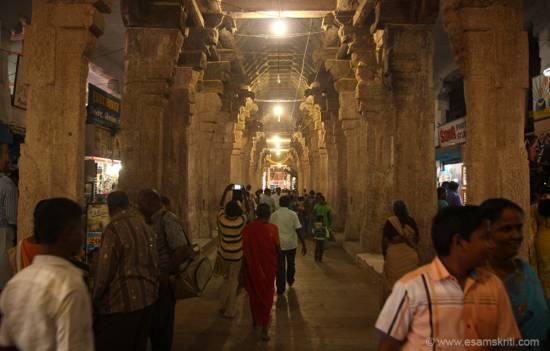 Inside Srivilliputhur
Temple i.e. about two hours away.
Inside Srivilliputhur
Temple i.e. about two hours away.
To read all articles
by author
Also see albums
1. Meenakshi Temple
2. Meenakshi Temple
Inside
3. Murugan Temple,
Madurai.
4. Sri Srivilliputhur
Temple
5. Nayak Palace
Madurai